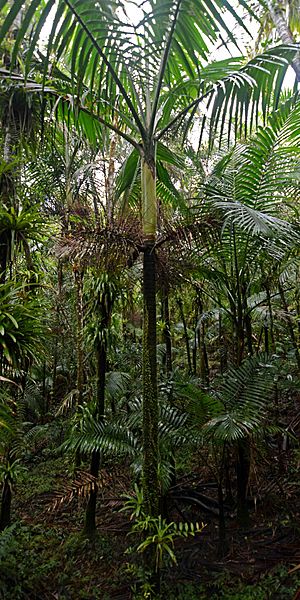Luquillo Mountain babyboot orchid facts for kids
Quick facts for kids Luquillo Mountain babyboot orchid |
|
|---|---|
| Conservation status | |
| Scientific classification | |
| Genus: |
Lepanthes
|
| Species: |
eltoroensis
|
The Lepanthes eltoroensis is a special kind of orchid. People often call it the Luquillo Mountain babyboot orchid. This tiny plant only grows in one place: the El Yunque National Forest in Puerto Rico. It lives mostly in the Luquillo Mountains. The orchid got its name from the El Toro Trail, a path in these mountains. Because it's so rare, the United States government has listed it as an endangered species. This means it needs special protection to survive.
Contents
Where the Babyboot Orchid Lives
The Luquillo Mountain babyboot orchid lives in the Luquillo Mountains within the El Yunque National Forest. It grows in specific forest areas, like those with sierra palm, palo colorado, and dwarf trees. This orchid is an epiphyte. This means it grows on other plants, like tree trunks, but it doesn't harm them. It just uses them for support. These trees are also home to other small plants like mosses and liverworts.
Scientists have found this orchid on only about 40 to 60 trees in the forest. All these trees are found at high elevations, over 2,789 feet (about 850 meters) above sea level. Recent studies show that more of these orchids grow along the Tradewinds Trail than the El Toro Trail. This might be because the Tradewinds Trail has more sierra palm trees, which create a good, shady home for the orchid.
What the Babyboot Orchid Looks Like
The Luquillo Mountain babyboot orchid is a very small plant. It's usually no longer than 4 centimeters (about 1.5 inches). Each plant has just one leaf and a few thin stems, usually three to seven.
This orchid is unique compared to other Lepanthes orchids. It has a longer flower stalk (called an inflorescence). Its leaves are shaped like an egg, wider at the top, and measure about 0.4 to 0.9 inches long and 0.2 to 0.4 inches wide. The edges of its sepals (part of the flower) are also hairy. The orchid's tiny flowers are only a few millimeters long. They have red or orange petals and usually rest against the leaf.
How the Babyboot Orchid Grows and Lives
The Lepanthes eltoroensis orchid tends to grow in a circular pattern around its host tree. It seems to prefer the northwestern side of the tree trunk.
On average, a Luquillo Mountain babyboot orchid lives for about 5.2 years. This can change depending on different things in its environment. Scientists are still trying to find out which specific insect pollinates this orchid. However, other Lepanthes species are pollinated by tiny black-winged fungus gnats.
Researchers believe that this orchid, and others like it, developed over time through a process called genetic drift. This happens when small populations have limited gene flow, leading to unique genetic differences.
Why the Babyboot Orchid is Endangered
This special orchid is listed as an endangered species for a few important reasons. One big threat is how forests are managed. Also, strong storms like hurricanes can damage its habitat. Sadly, some people have also tried to collect these rare plants. This has even led to the destruction of at least one group of these orchids that used to live in a sierra palm forest.
Protecting the Babyboot Orchid
The Lepanthes eltoroensis orchid has low genetic diversity. This means there isn't much variety in its genes, which can make it harder for the plant to adapt and survive changes in its environment. To help with this, scientists have suggested a special idea. They think that artificially cross-pollinating L. eltoroensis with another similar orchid, L. caritensis, could help. This might create new genetic combinations and make both species stronger.
Good news for the L. eltoroensis is that it can grow on many different types of host trees. This makes it more likely to survive compared to other Lepanthes orchids. It also means that moving the orchids to new, safe places might be easier and more successful if needed.
Images for kids





